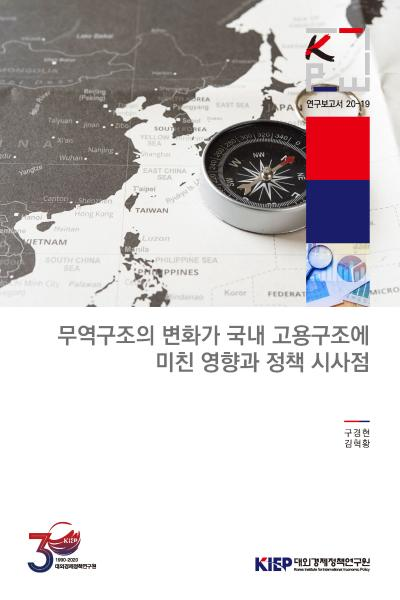Working Papers
Publications
Working Papers
To list

The Effects of the Increase in Korea’s Trade with China and Vietnam on Korean Labor Market and Policy Implications
Author Kyong Hyun Koo and Hyuk-Hwang Kim Series 20-19 Language Korean Date 2020.12.30
Korea’s trade with China and Vietnam has increased remarkably for the last decades and this trend is one of the most notable changes in the Korean trade structure since the 2000s. This study analyzes the impact of changes in the Korean trade structure caused by the rise of China and Vietnam on the changes in the domestic employment structure at the industry and occupation level, and examines how the changes affected workers’ earnings and employment security over a longer period.
This study finds that the increase in imports from/exports to China and Vietnam from 2003 through 2018 has caused significant changes in Korea’s manufacturing employment by industry and occupation. Specifically, the employment declined in industries that are more exposed to import competition from China and Vietnam (e.g., textiles, clothing, shoes, computers and video equipment, etc.), while the employment increased in industries with large export growth to China and Vietnam(e.g., machinery and equipment, precision equipment, semiconductors, ferroalloys, etc.). The fact that not only imports from but also exports to China and Vietnam rose sharply in Korea partly explains why Korean manufacturing employment rebounded from the mid-2000s, unlike other advanced countries.
In addition, the new employment for occupations that were exposed to high import competition from China and Vietnam (e.g., textile and clothing-related jobs, materials and construction-related jobs, etc.) tended to go down, while that for occupations exposed to increased exports to China and Vietnam (e.g., chemical and electrical engineering technicians, professional occupations related to natural science and life science, etc.) tended to go up, and the occupation- specific trade exposure effects was estimated to be greater than the industry-specific ones.
Also, we find a general tendency throughout the manufacturing industry that the share of management-related office jobs and low-tech production jobs increased whereas and the share of middle- skilled production jobs decreased. The fact that this tendency is found in import-competing industries as well as export-increasing ones suggests that the former not only reduces overall employment but changes the composition of workers’ occupations qualitatively in response to the increased import competition from China and Vietnam.
The changes in the employment structure caused by the trade shock from China and Vietnam further widened the gap of earnings and employment security among manufacturing workers in Korea. Specifically, the earnings of workers in industries that benefited from the increase in exports to China and Vietnam were found to rise significantly over 10 years, while the workers in import-competing industries experienced a lower growth rate in earnings and higher possibility of involuntary job displacement for the same period.
In addition, the decrease in earnings due to exposure to import competition from China and Vietnam was more pronounced for the low-educated workers than the high-educated ones. For older workers, in turn, the positive earnings effects due to the increase in industrial exports to China and Vietnam did not appear unlike younger ones. The earnings of workers whose occupation exposed to import (export) shocks from China and Vietnam also tended to grow less (more). The effects of occupational trade exposure on workers’ earnings appeared faster and larger than those of industrial trade exposure.
Sales Info
| Quantity/Size | 156 |
|---|---|
| Sale Price | 7 $ |
 공공저작물 자유이용허락 표시기준 (공공누리, KOGL) 제4유형
공공저작물 자유이용허락 표시기준 (공공누리, KOGL) 제4유형
대외경제정책연구원의 본 공공저작물은 "공공누리 제4유형 : 출처표시 + 상업적 금지 + 변경금지” 조건에 따라 이용할 수 있습니다. 저작권정책 참조
